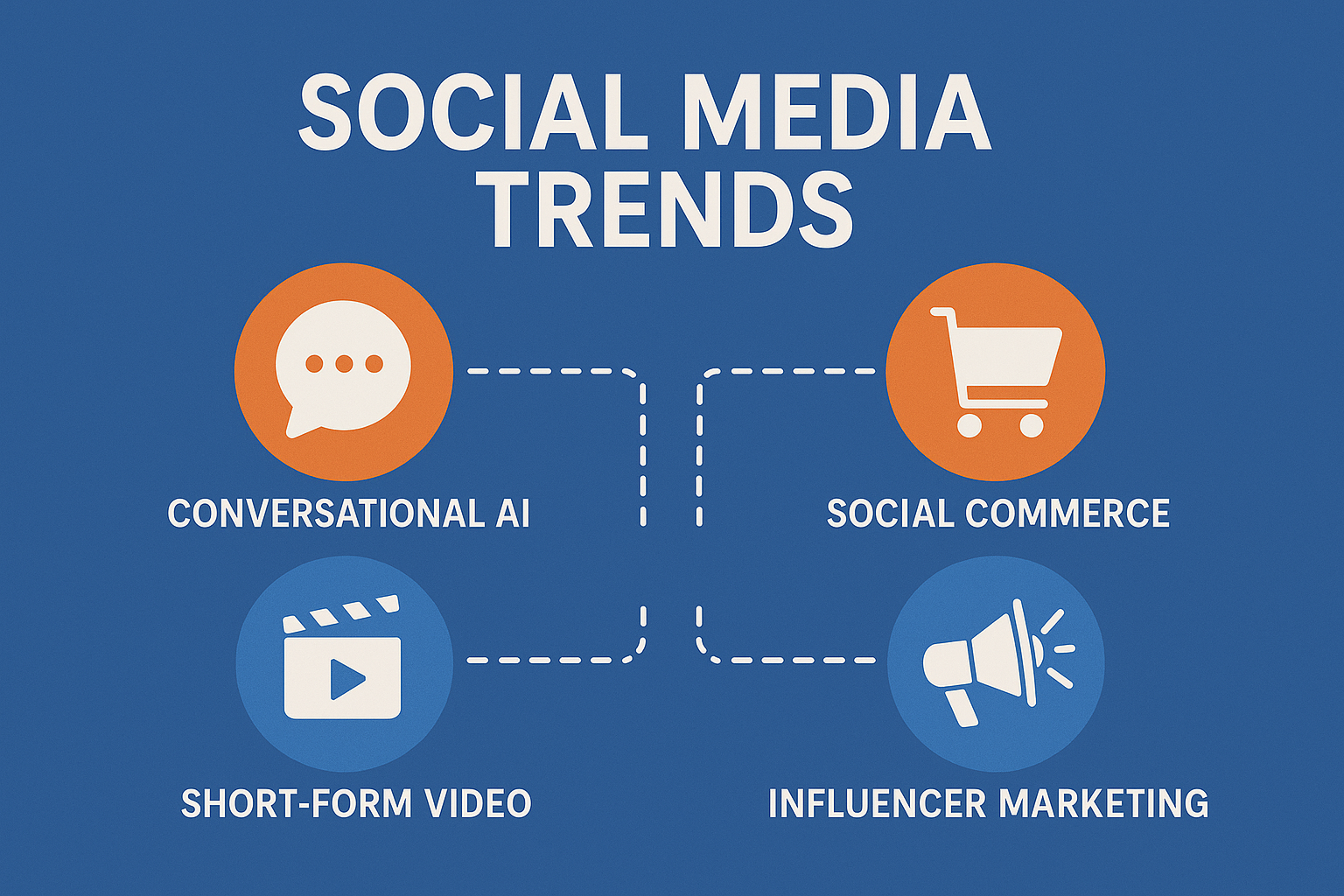Social media continues to evolve at an unprecedented pace in 2025, with emerging technologies and shifting user behaviors creating both new opportunities and challenges for brands. This article explores the key trends reshaping how businesses connect with audiences and drive meaningful engagement.
What You'll Learn
- AI-Powered Content Creation and Curation
- Immersive Social Experiences (AR/VR)
- Advanced Social Commerce Integration
- The Rise of Authenticity and Transparency
- Private Communities and Focused Engagement
- Social Responsibility and Value Alignment
- The Continued Evolution of Video
- Creator Economy Maturation
- Niche Platform Growth
- Implementation Strategies for Brands
AI-Powered Content Creation and Curation
Artificial intelligence has transformed how brands approach content creation and curation on social media platforms. In 2025, we're seeing AI's role expand from simple automation to becoming a strategic creative partner.
Key Developments:
- Multi-modal Content Generation: Advanced AI tools now create cohesive packages of text, images, and videos optimized for each platform's unique requirements
- Personalized Content Sequencing: AI systems determine optimal content sequences for different audience segments based on behavioral patterns
- Real-time Trend Adaptation: Tools that identify emerging conversations and automatically generate relevant content ideas
- Performance Prediction: AI that forecasts engagement metrics before content is published, enabling pre-posting optimization
- Cross-platform Adaptation: Systems that efficiently modify content to match the specific format requirements and audience expectations of different platforms
The most successful brands are using AI to handle routine aspects of content production while empowering their human teams to focus on strategy, emotional intelligence, and authentic connection—areas where humans still maintain a significant advantage over machines.
"AI isn't replacing human creativity in social media—it's amplifying it. The brands seeing the greatest success are those using AI as a collaborative tool that handles time-consuming tasks while enabling their teams to focus on what humans do best: strategic thinking, emotional intelligence, and authentic storytelling."
— Darshan Raj, CMO, Haricane Consultancy
Immersive Social Experiences (AR/VR)
Augmented reality (AR) and virtual reality (VR) have evolved from experimental features to mainstream social experiences. The widespread adoption of AR-capable devices and more accessible VR hardware has made immersive interactions increasingly common.
Immersive Social Stats for 2025
- 65% of social media users have engaged with at least one AR experience in the past month
- AR filters drive 3.2x higher engagement than standard posts
- Virtual social events have seen 180% growth year-over-year
- Brands using AR in their social strategy see 40% higher conversion rates
- 85% of Gen Z consumers expect brands to offer some form of AR interaction
Leading platforms have integrated AR and VR capabilities that allow users to:
- Experience Virtual Social Gatherings: Attend events, meetings, and hangouts in shared 3D spaces
- Try Products Virtually: Sample products before purchase with AR try-on features
- Create and Explore Digital Environments: Build and share custom virtual spaces
- Interact with Persistent AR Content: Engage with location-based AR content that remains in place for multiple users
- Participate in Mixed-Reality Experiences: Blend physical and digital elements in shared social experiences
Case Study: StyleVerse AR Campaign
Fashion retailer StyleVerse launched an augmented reality campaign allowing users to virtually try on their latest collection and share results with friends. The experience included customization options and virtual photoshoots in iconic locations.
Results:
- 3.2 million virtual try-ons in the first month
- 38% conversion rate from AR experience to purchase
- 285,000 user-generated content pieces shared
- 22% increase in average order value compared to traditional campaigns
Advanced Social Commerce Integration
Social commerce has matured dramatically in 2025, blending entertainment, community, and frictionless purchasing experiences. What began as simple "buy buttons" has evolved into sophisticated shopping ecosystems embedded within social platforms.
Key Social Commerce Trends:
- Live Shopping Evolution: Advanced live shopping streams featuring real-time product customization, multi-angle viewing, and interactive Q&A
- Social Showrooming: Virtual spaces where friends shop together and receive real-time advice from other customers or brand representatives
- Shoppable User Content: AI systems that identify products in user-generated content and make them instantly purchasable
- Community-Driven Commerce: Shopping experiences built around shared interests and community recommendations
- Integrated Payment Solutions: One-click purchasing with multiple payment options, including cryptocurrency and buy-now-pay-later services
The integration between social media and e-commerce has become so seamless that for many consumers—particularly younger demographics—social platforms are now the preferred shopping destination over traditional e-commerce websites.
The Rise of Authenticity and Transparency
After years of heavily filtered and polished content dominating social media, 2025 has seen a decisive shift toward authenticity, transparency, and genuine connection. This trend has been driven by consumer fatigue with overly produced content and growing skepticism toward traditional advertising approaches.
Successful brands are embracing this shift by:
- Behind-the-Scenes Content: Showing the real people and processes behind their products and services
- Transparent Business Practices: Openly discussing challenges, mistakes, and improvement efforts
- Employee Advocacy: Empowering team members to share their genuine experiences and perspectives
- Unfiltered Interaction: Engaging in real, sometimes messy conversations rather than sticking to polished scripts
- Customer Collaboration: Actively involving customers in product development and marketing initiatives
"The most significant shift we're seeing is from perfection to authenticity. Brands that present a flawless but unrealistic image are struggling, while those willing to be vulnerable, transparent, and genuine are building deeper connections that translate to measurable business results."
— Darshan Raj, CMO, Haricane Consultancy
Private Communities and Focused Engagement
As public social feeds become increasingly saturated and algorithm-driven, many users and brands are shifting toward private communities and more intimate digital spaces. These focused environments foster deeper connections and more meaningful engagement.
Private Community Statistics
- 72% of social media users belong to at least one private community
- Engagement rates in private groups average 10x higher than public feeds
- 78% of consumers trust recommendations from community members
- Brands with active private communities report 65% higher customer retention
- Members of brand communities spend 32% more annually than non-members
This trend appears across various formats:
- Messaging App Communities: Brand-hosted groups on WhatsApp, Telegram, and other messaging platforms
- Platform-Specific Groups: Private communities within major social networks
- Dedicated Community Platforms: Specialized spaces built around specific interests, professions, or goals
- Micro-Communities: Small, highly focused groups with strong connection among members
- Subscription Communities: Premium spaces offering exclusive content and experiences
Case Study: TechInnovators Messaging Community
Technology brand TechInnovators built a WhatsApp-based community of tech enthusiasts who received exclusive product information, early access to sales, and personalized support. The community became a valuable resource for product feedback and development insights.
Results:
- 95,000 active community members within 6 months
- 48% higher conversion rate compared to email marketing
- 82% message open rate and 27% click-through rate
- 37% of members shared content with their personal networks
- Customer lifetime value 2.8x higher for community members
Social Responsibility and Value Alignment
In 2025, consumers increasingly expect brands to take meaningful stands on social, environmental, and political issues. This shift goes beyond superficial "cause marketing" to authentic commitments that permeate all aspects of business operations and communications.
Effective approaches to social responsibility include:
- Consistent Values Integration: Embedding core values throughout all brand communications and actions
- Measurable Impact Initiatives: Creating programs with concrete, reportable outcomes
- Transparency on Progress: Openly sharing both achievements and areas for improvement
- Community Involvement: Engaging audiences in cause-related efforts rather than simply broadcasting them
- Authentic Advocacy: Supporting causes genuinely connected to the brand's purpose and stakeholder interests
Brands must navigate this landscape carefully, as consumers are increasingly skilled at distinguishing between authentic commitment and purpose-washing. Those who approach social responsibility as a fundamental business strategy rather than a marketing tactic are seeing the strongest results.
The Continued Evolution of Video
Video remains the dominant content format in 2025, but it continues to evolve in response to changing user preferences, technological capabilities, and platform priorities.
Key Video Trends:
- Hybrid Video Formats: Blending previously distinct formats (e.g., Stories + Live + Shopping) into integrated experiences
- Interactive Video Elements: Content with embedded polls, questions, branching narratives, and clickable elements
- Personalized Video: Content that dynamically adapts based on viewer data and behaviors
- Vertical-First Design: Full-screen vertical experiences optimized for mobile viewing
- Micro-Content Series: Interconnected short videos that build narratives across multiple posts
- AI-Enhanced Production: Tools that simplify high-quality video creation and editing
Platform-specific video strategies have become essential, as algorithms increasingly favor native content optimized for each platform's unique features and audience expectations. The most successful brands develop distinct approaches for each channel rather than cross-posting identical content.
Creator Economy Maturation
The creator economy has evolved from its early days into a sophisticated ecosystem with diverse business models, professional infrastructure, and increasing specialization.
Key developments in the creator landscape include:
- Creator Collectives: Formalized groups that collaborate, share resources, and negotiate with brands as unified entities
- Multi-Stream Revenue Models: Sophisticated monetization combining brand partnerships, direct audience support, products, and services
- Specialized Creator Tools: Professional-grade software and services designed specifically for content creators
- Creator-Led Brands: Influencers launching successful standalone businesses beyond personal branding
- Micro and Nano Specialization: Highly focused creators building valuable audiences in specific niches
For brands, effective creator partnerships now require more sophisticated approaches that go beyond transactional sponsorships to truly collaborative relationships. The most successful creator campaigns are those built on authentic alignment, long-term partnerships, and co-creation rather than one-off sponsored posts.
Niche Platform Growth
While major platforms continue to dominate the social landscape, 2025 has seen significant growth in specialized platforms catering to specific interests, demographics, or content types.
Emerging Niche Platforms
- Culinary.Social: Food-focused platform combining recipe sharing, ingredient sourcing, and cooking techniques
- CraftVerse: Community for makers, artisans, and DIY enthusiasts with integrated marketplace features
- GreenConnect: Sustainability-focused platform linking environmentally conscious consumers and brands
- SeniorSocial: Platform designed specifically for users 60+ with simplified interface and relevant content focus
- TravelTribe: Community connecting travelers with locals and fellow explorers for authentic experiences
These specialized platforms often offer brands unique opportunities to connect with highly engaged audiences in contextually relevant environments. While their user bases may be smaller than mainstream platforms, the higher relevance and engagement rates can deliver superior results for appropriate brands and campaigns.
Implementation Strategies for Brands
With social media continuing to evolve at a rapid pace, brands need strategic approaches to navigate these trends effectively. Here are key strategies for successful implementation:
Strategic Recommendations:
- Platform Prioritization: Focus resources on platforms that best align with your audience and content types rather than trying to maintain presence everywhere
- Value-First Content Strategy: Prioritize providing genuine value to your audience over promotional messaging
- Community Building Focus: Invest in fostering meaningful connections among your audience rather than just accumulating followers
- Authenticity Framework: Develop clear guidelines for maintaining brand authenticity across all social communications
- Balanced Automation: Use AI and automation tools strategically while maintaining human oversight and creative direction
- Measurement Evolution: Move beyond vanity metrics to more meaningful indicators of business impact and relationship quality
Embracing the Social Future
The social media landscape of 2025 offers unprecedented opportunities for brands to create meaningful connections, drive engagement, and generate business results. However, it also requires greater strategic sophistication, technological adaptation, and authentic community building than ever before.
The most successful social media strategies balance innovation with purpose, automation with human connection, and scale with personalization. By thoughtfully embracing these emerging trends while staying true to core brand values, marketers can create social media presences that resonate with audiences and deliver measurable business impact.
Need Help With Your Social Media Strategy?
Our team of social media experts at Haricane Consultancy Services can help you develop and implement a cutting-edge social strategy that leverages these trends while staying true to your brand identity and business objectives.
Schedule a Free Consultation



Comments (2)
Priya Sharma
February 11, 2025This is such a comprehensive overview of social media trends! I'm particularly interested in the private communities aspect. As a small business owner, I'm wondering what's the best way to start building a community on messaging apps without coming across as intrusive or spammy?
Darshan Raj
Author February 12, 2025Great question, Priya! The key to building messaging communities is to lead with value rather than promotion. Start by inviting your most engaged customers and offer them exclusive content, early access, or personalized support. Make it clear what they'll receive and how often you'll message them. Begin with a small group (25-50 people) and focus on facilitating conversations, not just broadcasting messages. As engagement builds, encourage members to invite others who might benefit. Remember that these spaces should feel special and different from your public social media presence.
Leave a Comment